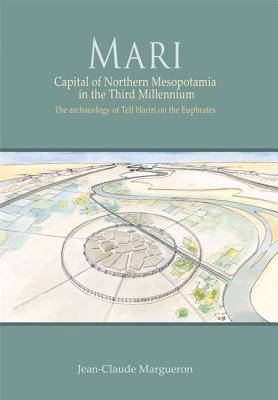
En raison d'une grêve chez bpost, votre commande pourrait être retardée. Vous avez besoin d’un livre rapidement ? Nos magasins vous accueillent à bras ouverts !
- Retrait gratuit dans votre magasin Club
- 7.000.000 titres dans notre catalogue
- Payer en toute sécurité
- Toujours un magasin près de chez vous
En raison de la grêve chez bpost, votre commande pourrait être retardée. Vous avez besoin d’un livre rapidement ? Nos magasins vous accueillent à bras ouverts !
- Retrait gratuit dans votre magasin Club
- 7.000.0000 titres dans notre catalogue
- Payer en toute sécurité
- Toujours un magasin près de chez vous
Mari
Capital of Northern Mesopotamia in the Third Millennium. the Archaeology of Tell Hariri on the Euphrates
Jean-Claude Margueron
Livre relié | Anglais
69,95 €
+ 139 points
Description
According to archaeological evidence gleaned over more than 70 years, Mari appears to have been the most important city in northern Mesopotamia from its foundation at about 2950 BC to 1760 BC. Situated at the heart of a river system and progressively linked with an overland network, Mari was the city that controlled the relations of central and southern Mesopotamia with the regions bordering the Taurus and Zagros mountains to the north and east and the Mediterranean coastal zone to the west. Mari drew its power from this situation, and the role it played accounts for the particularity of its features, positioned as it was between the Syrian, Assyrian, Iranian, Babylonian and Sumerian worlds.
The evidence shows that there was not one city of Mari, but three successive cities, each having specific features, although there is a striking permanence in the original forms. The first, City I, founded in about 2950 BC, was based on remarkable principles of city planning, including a broad regional development with the creation of canals for irrigation and transport, one more than 120 km long. In the 23rd century BC City II was founded using impressive technology in city planning. Probably destroyed by Naram-Sin of Akkad about 2200 BC, it was entirely reconstructed as City III by a new dynasty, the Shakkanakku. In the 19th century BC this was replaced by an Amorite dynasty, which ruled until Hammurabi of Babylon destroyed Mari in 1760 BC. The diversity of the information and material that has been recovered confirms Mari's place as one of the best sources for understanding the brilliant Mesopotamian civilisation that developed between the beginning of the 3rd and the end of the 1st millennium BC.
The evidence shows that there was not one city of Mari, but three successive cities, each having specific features, although there is a striking permanence in the original forms. The first, City I, founded in about 2950 BC, was based on remarkable principles of city planning, including a broad regional development with the creation of canals for irrigation and transport, one more than 120 km long. In the 23rd century BC City II was founded using impressive technology in city planning. Probably destroyed by Naram-Sin of Akkad about 2200 BC, it was entirely reconstructed as City III by a new dynasty, the Shakkanakku. In the 19th century BC this was replaced by an Amorite dynasty, which ruled until Hammurabi of Babylon destroyed Mari in 1760 BC. The diversity of the information and material that has been recovered confirms Mari's place as one of the best sources for understanding the brilliant Mesopotamian civilisation that developed between the beginning of the 3rd and the end of the 1st millennium BC.
Spécifications
Parties prenantes
- Auteur(s) :
- Editeur:
Contenu
- Nombre de pages :
- 176
- Langue:
- Anglais
Caractéristiques
- EAN:
- 9781782977315
- Date de parution :
- 17-12-14
- Format:
- Livre relié
- Format numérique:
- Genaaid
- Dimensions :
- 216 mm x 297 mm
- Poids :
- 938 g

Les avis
Nous publions uniquement les avis qui respectent les conditions requises. Consultez nos conditions pour les avis.






